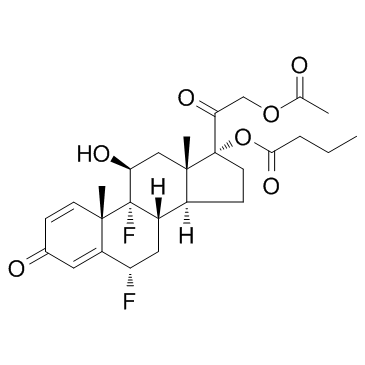Ocular distribution of difluprednate ophthalmic emulsion 0.05% in rabbits.
Tetsuya Tajika, Akiharu Isowaki, Hideyuki Sakaki
文献索引:J. Ocul. Pharmacol. Ther. 27(1) , 43-9, (2011)
全文:HTML全文
摘要
To evaluate ocular distribution and excretion of tritium-labeled difluprednate ((3)H-DFBA) ophthalmic emulsion 0.05% after a single or repeated instillation to pigmented rabbit eyes.(3)H-DFBA ophthalmic emulsion 0.05% was instilled in the right eyes of pigmented rabbits, in either a single or repeated quater in die (QID) for 3 days or 7 days) dose of 25 μg/50 μL. The radioactivity in right and left ocular tissues, urine, blood, plasma, and feces were measured with a liquid scintillation counter. Additionally, the distribution of radioactivity around ocular tissues was investigated with autoradiography.After a single instillation, the highest maximum radioactive concentrations were found in the cornea (2,081 ng eq./g), followed by the iris/ciliary body (926 ng eq./g), conjunctiva (330 ng eq./g), anterior retina/choroid (273 ng eq./g), sclera (222 ng eq./g), and aqueous humor (144 ng eq./mL) of treated eyes. The maximum radioactivity concentration of the posterior retina/choroid was 59 ng eq./g, and difluprednate delivered as a topical ophthalmic emulsion reached the back of the eye. However, radioactivity in untreated eyes was very low. Total radioactivity excreted in urine and feces 168 h after a single instillation was 99.5% of the total dose. Radioactivity concentration levels measured 24 h after 28 instillations were no more than twice those measured 24 h after 12 instillations. Radioactive concentrations in ocular and periocular tissues were highest at 0.5 or 1 h after a single instillation, and were mostly eliminated from these tissues by the end of the study. Radioactivity was barely detectable in the blood, with very little accumulation even after multiple doses.After instillation of (3)H-DFBA ophthalmic emulsion 0.05% in rabbit eyes, radioactivity was distributed at the anterior segment and cleared rapidly. Some radioactivity was detected in the posterior retina/choroid, suggesting that difluprednate and its metabolites reach these tissues. These results suggest that difluprednate delivered as a topical ophthalmic emulsion reached the anterior and posterior segments of the eye quickly and may be a potential treatment for ocular inflammation in these areas.
相关化合物
| 结构式 | 名称/CAS号 | 分子式 | 全部文献 |
|---|---|---|---|
 |
二氟孕甾丁酯
CAS:23674-86-4 |
C27H34F2O7 |
|
Topical cyclosporine a 1% for the treatment of chronic ocula...
2014-09-01 [Eye Contact Lens 40(5) , 283-8, (2014)] |
|
Determination of natural and synthetic glucocorticoids in ef...
2015-09-01 [Environ. Sci. Pollut. Res. Int. 22 , 14127-35, (2015)] |
|
Pharmacokinetic features of difluprednate ophthalmic emulsio...
2011-02-01 [J. Ocul. Pharmacol. Ther. 27(1) , 29-34, (2011)] |
|
Difluprednate 0.05% versus prednisolone acetate 1% for endog...
2014-05-01 [Invest. Ophthalmol. Vis. Sci. 55(5) , 2993-3002, (2014)] |
|
Analysis of an anti-inflammatory steroidal drug, diflupredna...
2003-01-15 [J. Pharm. Biomed. Anal. 30(6) , 1735-42, (2003)] |